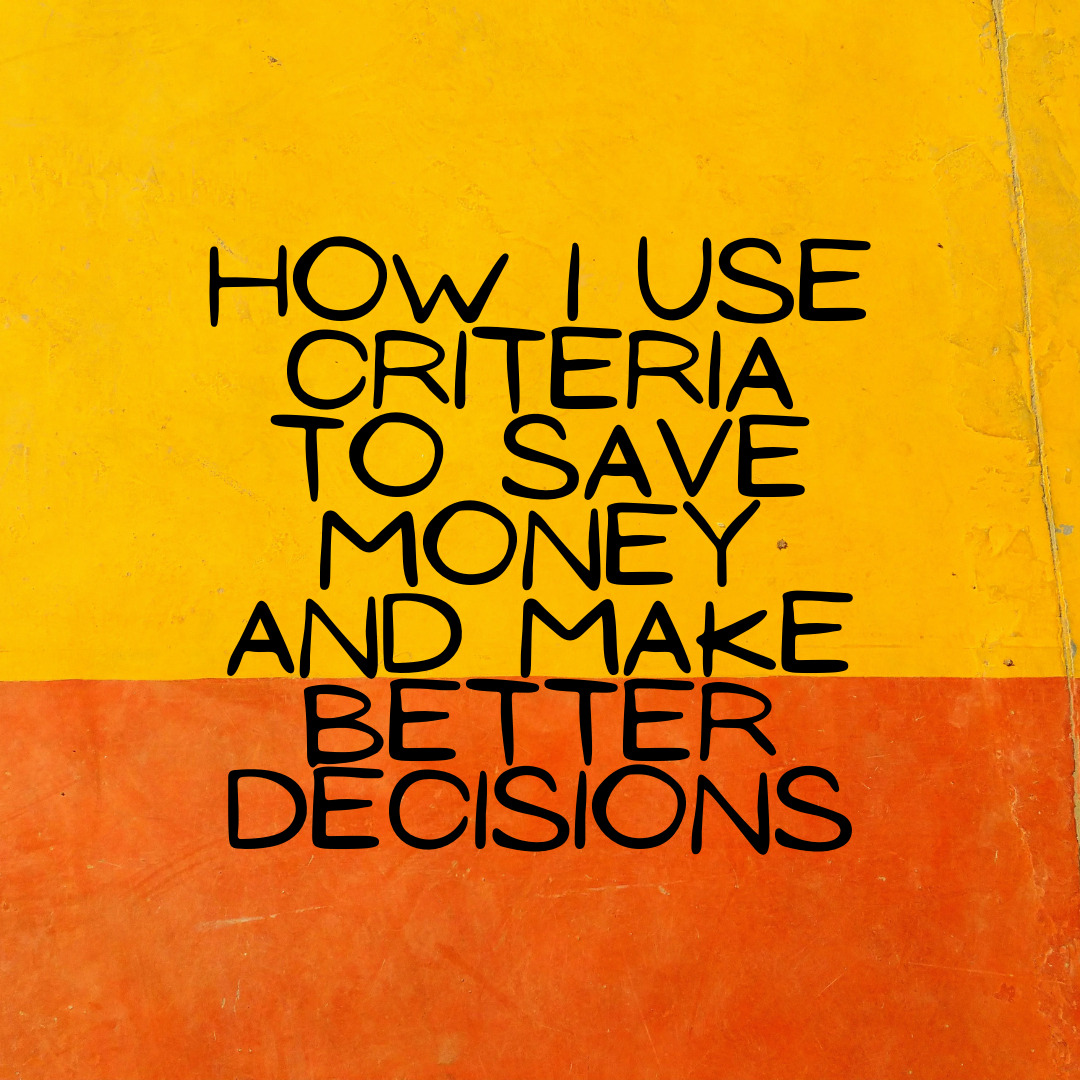In my last blog, I wrote about how I saved $50 in 45 seconds. The way I did it was by setting criteria. I have criteria, or standards, for almost everything. Shopping at the store, buying a car, purchasing rental properties, where to live, and where to vacation to name a few.
Having criteria makes life a lot simpler. Do some work in the beginning to establish criteria and then make decisions based upon it. Criteria gives you something real to guide you in the decision making process.
Real Life Example
I am looking to purchase a rental property in the Ft. Worth area. I know the area well and have purchased there before. Rather than look online at a bunch of houses in varying price ranges and areas, I set specific criteria.
- Total price under $165,000 including rehab costs
- City: Haltom City, N Richland Hills, Saginaw, Euless, Hurst, Arlington, Watauga, Keller, Ft. Worth (76107, 76110, 76116, 76123, 76133, 76134, 76140)
- Minimal to no rehab costs
- Monthly rent > or slightly below 1% of total cost
- No HOA
- >1,500 sq. ft.
- 3 bedroom/2 bath
- Cash flow >$150/month
- Schools rated 6+
- Vacant or exceptional tenant in place
If I find a property that meets all the criteria, I will make an immediate offer. A property meeting all of the above criteria will require very little thinking and analyzing because I’ve already done the upfront work, and know what a great deal looks like. A great deal for you probably will look a little different, that’s why it’s important for people to set their own criteria.
Here’s the caveat: this criterion is going to be very difficult to meet. It’s almost a unicorn in a field of rising prices and competition. That’s why I also created criteria for “likely purchase”, “maybe purchase” and “avoid.”
Any property in the “likely purchase” category will be open for review. Most of the upfront work has been done, so any property in this category will likely pass through to making an offer. It shouldn’t take more than a half hour to decide whether to put in an offer.
The “maybe purchase” category will take a little more work. The fact that the property meets the “maybe” criteria means it needs to be looked at much more carefully. “Maybe” is criteria I’ve set to let myself know to take a more in depth analysis for anything that may have been overlooked, or for hidden deals.
Finally, I’ve got the category of “avoid.” The “avoid” criteria saves me time because I already know what I don’t want, and any property in this category meets that. There is no use in exploring it more because I’ve already done the upfront work and know the property will never meet my buying criteria.
The Job
To give another example, imagine a recent college graduate looking for her first “real” job. Setting criteria upfront will save her countless hours going through position descriptions, answering recruiter inquiries, and interviewing.
Here’s her criteria:
- Located in Austin, Nashville, Atlanta, Dallas, Charleston, or Denver
- Starting pay $50,000+
- Potential to earn bonuses of $10,000+ every year
- Large company with over 100 employees
- Paid time off at least 2 weeks per year
- Above average medical and dental benefits
- Highly rated company
- Flexibility to work from home two days per week or more
- Company with a history of promoting from within
- Must be directly related to field of study in college
Setting criteria like this will allow the recent graduate to quickly identify job opportunities that meet her specific criteria. A job opportunity meeting all the criteria will go straight to the top of her list, allowing her to focus more time researching the company and preparing for the interview. A job opportunity meeting most of her criteria will also be pursued. An opportunity meeting little of her criteria will likely not be pursued.
The Car
As our last example, let’s use someone with a smaller, yet important, decision. What kind of car to purchase. Here’s his criteria:
- Under $15,000
- 70,000 miles or less
- 4 door sedan
- 2017 or newer
- High safety ratings
- No accidents
- Fuel efficiency 35 mpg or better
- Blue, black, gray, or white
This is actually much easier than our last two examples because the car buyer can just enter his criteria into an online search and find cars meeting his exact specifications. Since he’s specific with his criteria, it’s easy to leverage online resources to help with this decision.
Imagine though if he had no buying criteria. There would be literally thousands of cars to look through. SUV’s, sedans, sports cars, trucks. Old cars, new cars, high mileage vehicles, etc. It would be a total mess. Setting criteria weeds out what he doesn’t want and only leaves the types of vehicles he wants.
Reticular Activating System (RAS)
I try to be as efficient as possible. Setting criteria is one area of my life that I have complete control over. That doesn’t mean I’ll be able to find things that meet all my criteria one hundred percent of the time, but I have control over the criteria that I set.
In my book Cash Uncomplicated, I write about the reticular activating system (RAS). The original purpose of the reticular activating system was to help humans spot trouble like hungry animals trying to eat you. The RAS allowed the brain to hyper-focus on certain areas of their environment to help avoid danger.
As we have evolved though, we can use the RAS for more than just spotting trouble. We can actually use the RAS to train our brains on what to look for, not just avoid. That’s one of the reasons it’s so important to have criteria.
Setting criteria gives our mind specific instructions on what to look for. And that criteria gives us a framework that allows us to better engage our reticular activating system.
Summary
Consistently setting criteria will make your life easier. Criteria is a roadmap (or more likely GPS) for what you want—a guide in your decision making process. Think about taking a road trip from San Francisco to New York City.
New York City is a specific destination, so you can set your GPS to find the best route to get there. You’ve got an actual plan. But if you just told yourself that you’re going to drive somewhere “far”, you’d really have no idea of where you’re going. You might start one way, turn around, then go another way, and then another. There’s a good chance you would just make a big circle.
Allow your criteria to be your roadmap, or GPS. I think you’ll find that your life will get a lot easier when you know what you want.





